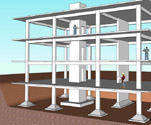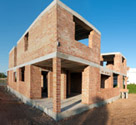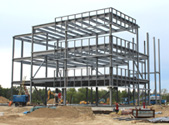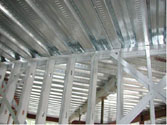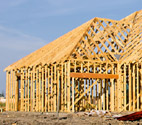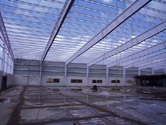PRECAST CONCRETE CONSTRUCTION
Precast concrete is an alternative to cast-in-situ concrete. While cast-in-situ concrete is cast in its actual location, precast concrete is cast at another location, either at the building site or in a factory, and is then lifted to its final resting place and fixed securely. This means that unlike cast-in-situ construction, which is monolithic or continuous, precast concrete buildings are made of separate pieces that are bolted or connected together.
advantages of precast construction
Precasting is great for producing large numbers of identical components. Let's say we are building an affordable housing project with 3,000 identical apartments. We could then use precasting to produce wall slabs and floor slabs for all the apartments, and then lift them into place and connect them.
Since it is done in a purpose-built precasting yard or factory, it makes construction easier for the following reasons:
This means that the quality of precast components can be very high.
Since the components can be made beforehand, construction can be very quick. In cast-in-situ construction, engineers have to build each set of components after the previous set has finished, which does take time, as concrete generally takes 28 days to reach its full strength.
Since it is done in a purpose-built precasting yard or factory, it makes construction easier for the following reasons:
- The construction is done on the ground rather than at a height
- It can be done inside a climate-controlled structure, eliminating problems of rain, dust, cold, or heat
- Specialised formwork (moulds) can be built for doing many repetitions of the same component
- Specialised equipment can be used to make, move, and pour the liquid concrete
- Curing of the concrete can be done in a controlled environment
This means that the quality of precast components can be very high.
Since the components can be made beforehand, construction can be very quick. In cast-in-situ construction, engineers have to build each set of components after the previous set has finished, which does take time, as concrete generally takes 28 days to reach its full strength.
disadvantages of precasting
There are a few main disadvantages of precast concrete construction:
- Since each piece is made separately, the structural frame or system is not monolithic or continuous like regular concrete construction. The joints between pieces create structural discontinuity. The forces of the building will pass through these joints, so they have to be designed to transfer these forces safely and properly. Note that precast concrete can be used for non-structural members too.
- Again, as the building is made of discrete components, the joints between adjacent members have to be sealed with special sealants to make them waterproof
- Each precast component is usually large and heavy. This means that cranes are required to lift them in position; these cranes are required to operate over the entire building volume. Since there will only be a few cranes at site, the time taken by the cranes to pick up a piece and shift it to its final position becomes critical in determining the building schedule.
how and where precasting is used
Reinforced concrete is a material usually used for structural systems due to its strength, durability, and affordability. Precast concrete is used in the following ways:
- to make beams, columns, floor slabs, foundations, and other structural members for buildings
- to make wall or cladding panels for buildings
- to make precast pre-stressed elements for buildings (see below)
- to make components for infrastructure projects: elements such as bridge spans, or metro line viaducts are often precast in a casting yard
- to make products for sale: precast water tanks, septic tanks, drainage chambers, railway sleepers, floor beams, boundary walls, water pipes are all available
- Since it can be moulded into any shape, it can also be used to create one-off unusual forms such as boats, sculptures and suchlike..
site vs. factory precasting
Precasting can be done at a casting yard, in or near the site, or in a factory. A key aspect of determining whether to use site or factory precasting are the transport costs. Factory work offers superior quality for obvious reasons, so if there is a factory close to the site, it makes sense to use it.
If a precasting yard is to be created, space must be laid out for the following activities:
For infrastructure projects, a casting yard is created on a piece of open land in the city. It is important that this be located near a major highway, as the precast elements can be very large or heavy, and cannot be taken through narrow roads.
If a precasting yard is to be created, space must be laid out for the following activities:
- storing the raw materials, such as cement, aggregate, sand, admixtures, water, reinforcement bars, and steel or plywood sheets for formwork
- a formwork making and maintenance yard
- a concrete mixing plant
- a steel reinforcement yard to make rebar cages to be placed inside the concrete
- a casting area
- a curing area
- a stacking area for finished components
For infrastructure projects, a casting yard is created on a piece of open land in the city. It is important that this be located near a major highway, as the precast elements can be very large or heavy, and cannot be taken through narrow roads.
connecting precast concrete elements
Precast concrete components can be connected in a number of ways:
1. They can be bolted together. In order to do this, steel connectors are embedded in the concrete at the time of casting. This must be done with great precision.
2. They can be grouted or concreted together. In this method, loops of steel reinforcement are left protruding out of the precast concrete members. Two members are placed in position, and reinforcement is threaded between the loops. Fresh concrete is then poured around this reinforcement, in a space left for this purpose.
1. They can be bolted together. In order to do this, steel connectors are embedded in the concrete at the time of casting. This must be done with great precision.
2. They can be grouted or concreted together. In this method, loops of steel reinforcement are left protruding out of the precast concrete members. Two members are placed in position, and reinforcement is threaded between the loops. Fresh concrete is then poured around this reinforcement, in a space left for this purpose.
